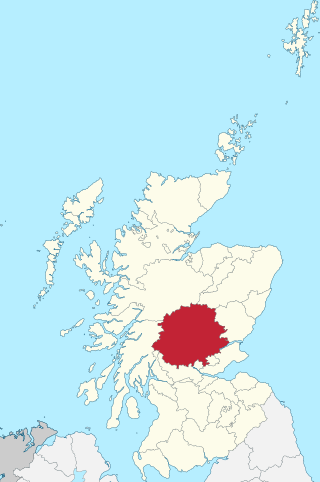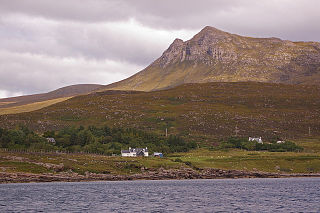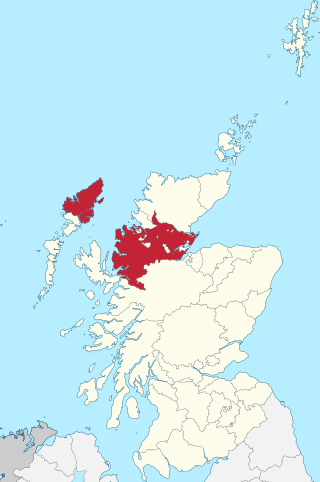
Perthshire, officially the County of Perth, is a historic county and registration county in central Scotland. Geographically it extends from Strathmore in the east, to the Pass of Drumochter in the north, Rannoch Moor and Ben Lui in the west, and Aberfoyle in the south; it borders the counties of Inverness-shire and Aberdeenshire to the north, Angus to the east, Fife, Kinross-shire, Clackmannanshire, Stirlingshire and Dunbartonshire to the south and Argyllshire to the west.

Cromartyshire was a county in the Highlands of Scotland, comprising the medieval "old shire" around the county town of Cromarty and 22 enclaves and exclaves transferred from Ross-shire in the late 17th century. The largest part, six times the size of the old shire, was Coigach, containing Ullapool and the area north-west of it. In 1889, Cromartyshire was merged with Ross-shire to become a new county called Ross and Cromarty, which in 1975 was merged into the new council area of Highland.

Dingwall is a town and a royal burgh in the Highland council area of Scotland. It has a population of 5,491. It was an east-coast harbour that now lies inland.

Ross and Cromarty, is an area in the Highlands and Islands of Scotland. In modern usage, it is a registration county and a lieutenancy area. Between 1889 and 1975 it was a county.

Earl of Cromartie is a title that has been created twice, both for members of the Mackenzie family. It was first created as Earl of Cromarty in the Peerage of Scotland in 1703 for Sir George Mackenzie, 2nd Baronet, but his titles were forfeited after the Jacobite rising of 1745. It was recreated in 1861 in the Peerage of the United Kingdom for Anne Sutherland-Leveson-Gower, Duchess of Sutherland. Since 1979, the Earl of Cromartie has been chief of Clan Mackenzie.

Skye and Lochalsh was a local government district, created in 1975 as one of eight districts within the Highland region in Scotland. It include the Isle of Skye and the Lochalsh area on the mainland. The main offices of the council were in Portree, on the Isle of Skye. The district was abolished in 1996 when Highland was made a single-tier council area.
The Lord-Lieutenant of Inverness is the British monarch's personal representative in an area which has been defined since 1975 as consisting of the local government districts of Inverness, Badenoch and Strathspey, and Lochaber, in Scotland, and this definition was renewed by the Lord-Lieutenants (Scotland) Order 1996. The area of the lieutenancy used to be the county of Inverness, which was abolished as a local government area by Local Government (Scotland) Act 1973. The districts were created, by the 1973 act, as districts of the two-tier Highland region and abolished as local government areas under the Local Government etc. (Scotland) Act 1994, which turned the Highland region into a unitary council area.
This is a list of Lord Lieutenants of Cromartyshire, Scotland.
The Lord Lieutenant of Caithness is the British monarch's personal representative in an area defined since 1975 as consisting of the local government district of Caithness, in Scotland. This definition was renewed by the Lord-Lieutenants (Scotland) Order 1996. Previously, the area of the lieutenancy was the county of Caithness, which was abolished as a local government area by the Local Government (Scotland) Act 1973. The district was created under the 1973 act as a district of the two-tier Highland region and abolished as a local government area under the Local Government (Scotland) Act 1994, which turned the Highland region into a unitary council area.

Coigach is a peninsula north of Ullapool, in Wester Ross in the Northwest Highlands of Scotland. The area consists of a traditional crofting and fishing community of a couple of hundred houses located between mountain and shore on a peninsula looking over the Summer Isles and the sea. The main settlement is Achiltibuie. Like its northerly neighbour, Assynt in Sutherland, Coigach has mountains which rise sharply from quiet, lochan-studded moorland, and a highly indented rocky coast with many islands, bays and headlands. The highest summit is Ben Mor Coigach at 743 metres; the distinctive profile of Stac Pollaidh is the other main peak within Coigach. The scenic qualities of Coigach, along with neighbouring Assynt, have led to the area being designated as the Assynt-Coigach National Scenic Area, one of 40 such areas in Scotland.

Ross-shire, or the County of Ross, was a county in the Scottish Highlands. It bordered Sutherland to the north and Inverness-shire to the south, as well as having a complex border with Cromartyshire, a county consisting of numerous enclaves or exclaves scattered throughout Ross-shire's territory. The mainland had a coast to the east onto the Moray Firth and a coast to the west onto the Minch. Ross-shire was named after and covered most of the ancient province of Ross, and also included the Isle of Lewis in the Outer Hebrides. The county town was Dingwall.
Sir John Stirling, KT, MBE, TD was a Scottish soldier and politician.
Colonel Sir Hector Munro was a Scottish chief and military officer. He was the 32nd Chief of the Scottish Highland Clan Munro, 29th Baron and 11th Baronet of Foulis.
This is a list of people who have served as Lord Lieutenant of Ross-shire. The office was replaced by the Lord Lieutenant of Ross and Cromarty in 1889 through the operation of the Local Government (Scotland) Act 1889, which directed that the incumbent Lord Lieutenant of Ross-shire should automatically assume the new post.
Sir Alexander Matheson, 1st Baronet, JP, DL was a British China merchant, Liberal Member of Parliament, and railway entrepreneur.
Sir Hector Munro, 1st Baronet of Foulis was a Scottish soldier, noble and clan chief of the highland Clan Munro. He is also by tradition the 19th Baron and 22nd overall chief of the clan. He is however the 12th chief of the Clan Munro who can be proved by contemporary evidence.

Clan Munro is a Highland Scottish clan. Historically the clan was based in Easter Ross in the Scottish Highlands. Traditional origins of the clan give its founder as Donald Munro who came from the north of Ireland and settled in Scotland in the eleventh century, though its true founder may have lived much later. It is also a strong tradition that the Munro chiefs supported Robert the Bruce during the Wars of Scottish Independence. The first proven clan chief on record however is Robert de Munro who died in 1369; his father is mentioned but not named in a number of charters. The clan chiefs originally held land principally at Findon on the Black Isle but exchanged it in 1350 for Estirfowlys. Robert's son Hugh who died in 1425 was the first of the family to be styled "of Foulis", despite which clan genealogies describe him as 9th baron.
Sir Kenneth Smith Mackenzie, 6th Baronet was a British diplomat, landowner and Lord Lieutenant of Ross and Cromarty 1881-1899.
The Sheriff of Ross, Cromarty and Sutherland was historically responsible for enforcing law and order in Ross-shire, Cromartyshire and Sutherland in Scotland.
The Sheriff of Caithness was historically the royal official responsible for enforcing law and order in Caithness, Scotland.